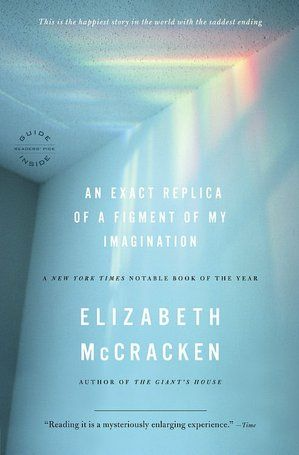When a Memoir is for the Writer and Not the Reader
I wrote the book quickly and without—oh dear, I hate to admit this—too much thought. I barely revised. I knew everything about the story before I even started. Novels are agony. Life is agony, but for me writing the memoir was not. ~ E. McCracken
 Elizabeth McCracken who studied in Iowa, is a fellow of this and a nominee of that, and yes, a remarkably talented wordsmith. See for yourself. She’s also witty and wry in the classic tradition of a Kate Hepburn heroine. Saucy. Quick-witted. Clever. Cool.
Elizabeth McCracken who studied in Iowa, is a fellow of this and a nominee of that, and yes, a remarkably talented wordsmith. See for yourself. She’s also witty and wry in the classic tradition of a Kate Hepburn heroine. Saucy. Quick-witted. Clever. Cool.
Those are great qualities to have as a writer, and certainly a writer of fiction, and common in these times of abounding cynicism. But when it comes to memoir, at least from my own perspective, they are not qualities that necessarily help a reader draw close to the story or the storyteller. It’s a bit like wrapping your arms around a porcupine.
“I never intended to write a memoir. I’m bored by myself and pathologically private,” McCracken writes in the back copy of this memoir which makes me venture to guess there was a lot of inner turmoil and resentment in the creation. “I felt morbid for remembering it,” she continues. “As though people would disapprove.”
So, in this post, I’m going provide an overview of this book, point out a couple of crafty things you might try in your own memoir, and discuss this writers prickly disposition, including it’s impact on the reader.
The Overview
An Exact Replica of a Figment of my Imagination is billed as the saddest book with the happiest ending, and is about the stillbirth of McCracken’s first child and the successful birth of her second child. It’s an accounting, moment by moment and decision by decision, of that first pregnancy through the birth and is positioned alongside the future where she has her second child. Death and life holding hands.
McCracken sets up this structure in the opening of the book: A child dies in this book: a baby. A baby is stillborn. You don’t have to tell me how sad that is: it happened to me and my husband, our baby, a son…A baby is born in this book, too. That is to say, a healthy baby, our second child.
If you have suffered aa stillbirth or a miscarriage, there is a quality here that will be extremely satisfying because McCracken calls out the insensitive things people say about such a loss which honestly should be called out. “It wasn’t meant to be.” “It was probably for the best.” “What are you so upset about, it wasn’t a person yet.”
The rest of the book is an accounting, or what I call “reporting”: This happened. That happened. There is an underlying conclusion that the death was at least, in part, the result of the French medical system and the players in that system who made the mistakes along the way. At one point, all of France becomes a scapegoat as this poor couple leaves the country for what we are told is the last time.
There’s also a sorting out of friends and acquaintances, a reshuffling of those who responded to the loss and how, and McCracken’s discovery or disappointment in each. In the end, you get a sense a personal world has been reshuffled and life continues on.
It’s an economical read. You can get in and out in a single night.
Crafty Technique #1: A strange and evocative title
We can likely agree that this is the strangest (and longest title) for a book we’ve seen. An odd title choice is common with writers at this level of literary prowess. Looking into this book for the source, we have to wait until the second to last paragraph: There’s a strange museum/gift shop/antique store/tourist trap in Schuylerville, New York, the next town over. In front is a reconstruction of colonial Fort George done in wood cutouts—a soldier in stocks, Revolutionary soldiers in profile, all cut with a jigsaw and painted in bright colors. In front is a sign that says: An exact replica of a figment of my imagination, and that is what this feels like some days. It’s a happy life, but someone is missing. It’s a happy life, and someone is missing. It’s a happy life—
It’s clever. It’s smart. And it can help to make you feel…elevated…intellectually, too, because you’ve been shown this odd little motif from the Revolutionary War which—if you give it a bit of thought—could be a symbol of the war raging inside this mother throughout this story, her many battles which (by this title) are now reduced to cutout profiles frozen in place. Mark Doty uses a similar motif in his memoir, Firebird. Go check it out.
Can you find something, some oddity, some image, some completely unrelated poem or object that captures your whole story in this way and snag a title from it? Try and you might be surprised what you discover. Plus, it’s so very in vogue, it will elevate the attention paid to your book when time to reach out to an agent.
Crafty Technique #2: The story before the story
Another common technique in the high literary world is the use of an opening story that is indirectly about the primary story. Debra Gwartney’s memoir, Live Through This, about a mother whose older daughters run away and live on the streets, opens with the writer on a bus and seeing a young girl, obviously homeless and addicted, and the disregard of the people on that bus to the girls obvious plight. This allows Gwartney to give us a sense of what the book is about and that all that is in past now. Doty’s Firebird, mentioned above, is another example. Here, in Figment, McCracken opens with a light, self-deprecating story of being at a book reading (“badly attended”) and how she must endure those who linger after the reading, to include one woman who called her stories “irrelevant.” The last attendee is a woman who lost a child and suggests McCracken write a book on the lighter side of losing a child. “You’re very funny.”
“She was a childish, unnerving person,” McCracken writes. “I imagined she’d been trying people’s patience for some time…and it seemed like the saddest thing I’d ever heard, back before I knew how sad things could get.”
This kind of opening is a way for the reader to meet the writer and become acquainted with her tone, perspective, control, writing ability, and even state of mind in relation to the topic. And, an opening like this can be helpful in that it allows the reader to start on the shallow end of difficult tales, which is why you so often see it used with memoir.
Tone
 The consensus in the Studio was that people found this a tricky book to love, and to stick with.
The consensus in the Studio was that people found this a tricky book to love, and to stick with.
While I ate it up when I first read it years earlier (in my infancy as a creative writer), this time around, I had to agree. While I found the story horribly sad and there were many insights I’ll never forget, I was struck by the grief not fully felt but rather directed into judgement and rage. It was justifiable grief and rage, no doubt, but ultimately tiresome. We read memoir to see into and through to the other side of our human experience, not to be held hostage by the lack of consciousness of the writer.
But that’s what we get when an author invests four weeks into writing her book which McCracken tells us in the back commentary. “I barely revised.”
This is what I’d call “reporting,” also known as “this happened, that happened,” and while McCracken can get away with it, many of us cannot. Worse, when we see a memoir like this on the shelf, adored and acclaimed, we think, “Why can’t I burn out my memoir in four weeks and get it published? What’s wrong with me?”
First of all, getting out of pain is totally understandable. No one wants to suffer and it’s part of our nature to lean into pleasure, even the pleasure of denial rather than to turn toward pain. But this instinctual tendency always backfires because what we resist persists. Being with what we struggle with, to include hardship and confusion and sorrow is called grieving and if we stick with it, we earn valuable qualities like humility and courage and wisdom.
As for how fast McCracken got the job done and comparing yourself to her: I urge caution. ⚠️
McCracken was, by the time Figment released, an established fiction writer, teacher, graduate of the Iowa Writers Workshop, and had a nomination for a National Book Award for In the Giant’s House. The time she took is commensurate to what was expected of her by the business of publishing. A writer like McCracken can easily get away with an “on the surface ” memoir. That’s the business. But that’s the business is not why we write (or I hope it’s not why we write).
I am a reader who loves depth, and going the distance into the unknown territory of the soul, but if you look around at the world we live in, this is not the case with a lot of people. In fact, I’d say the majority of folks want to do everything possible to avoid depth. So, I might suggest you find the middle ground. What can you write about your experience that is deep-ish, wise-ish? And as you are asking these questions, what can you do to improve your scene writing and your progressions and your development of the inner and outer arc?
The bottomline is that you only grow in craft by writing, a lot, and that is something McCracken has done (and continues to do). She’s studied hard. She’s worked hard. She teaches creative writing. She reads all the time. And she lives her art.
No matter what we think of this particular book, we can honor her devotion to her art form and learn from that!
Looking forward to your thoughts.


This is so cool. Way back in 2002 after I got laid off from my cushy Silicon Valley job and found myself on Maui, I decided that I was going to write my memoir in six months. It’s a story about my search for my birthmother and introducing myself to her on the day she died. The Maui Writers Conference was scheduled for Labor Day weekend and I was going to wow an agent. Whatever agent I pitched rejected my 1st manuscript a year later. She passed because my story needed depth of insight and an ending that hadn’t presented itself yet. Guess what! Two weekends ago, my ending finally presented itself. Good thing I’m patient.
Great share, Ana! TY